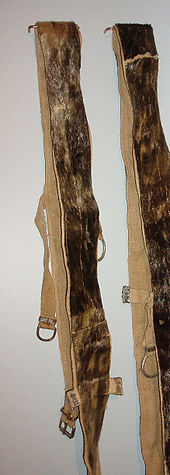Ski skin
The ski skin (also called climbing skin ) is a climbing aid. The ski skins are attached to touring skis and provide support on the snow during ski touring ascent . They prevent the skis from slipping backwards and at the same time allow sliding forwards.
In the past, seal skins or other natural skins were mostly used, today ski skins consist of a pile of fur made of synthetic fibers (mostly polyamide ) or mohair . Mohair offers optimal properties for use as a ski skin, because this fine, but robust natural fiber absorbs almost no moisture and remains soft and supple even in very cold weather. The sliding properties of pure mohair skins are noticeably better than those of synthetic fibers, especially in intensive use and at low temperatures. So that climbing becomes possible in the first place, the pile of fur must be laid in a complex process and fixed parallel to the direction of travel. A polyester-reinforced cotton back stabilizes the pile of fur and increases the tear resistance of the fur.
Most modern ski skins are tensioned adhesive skins, so they are glued to the ski with a special (residue-free and cold-resistant) adhesive and additionally attached to the ski tip or end with eyelets. A new variant are skins that stick to the ski without glue, only through adhesion .
If skins offer too little hold in difficult conditions (steep terrain, hard snow), crampons can also be used.
Skin-covered skis of the Chanten
Individual evidence
- ↑ Duden: Keyword climbing skin
- ↑ Alexander Tuma: Pelzlexikon XXI. Volume, Verlag Alexander Tuma, Vienna 1951, keyword seals
- ↑ Montana: climbing Elle . Last accessed December 3, 2015
- ↑ Bergretter, Austrian Mountain Rescue Service: "Gecko": A new type of climbing skin for touring skis against frustration with adhesive skin . Last accessed December 3, 2015


